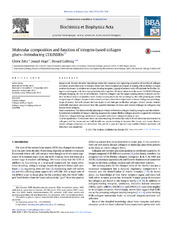| dc.contributor.author | Zeltz, Cedric | en_US |
| dc.contributor.author | Orgel, Joseph | en_US |
| dc.contributor.author | Gullberg, Donald | en_US |
| dc.date.accessioned | 2014-12-19T10:09:28Z | |
| dc.date.available | 2014-12-19T10:09:28Z | |
| dc.date.issued | 2014-08 | eng |
| dc.identifier.issn | 0304-4165 | |
| dc.identifier.uri | https://hdl.handle.net/1956/8989 | |
| dc.description.abstract | Background: Despite detailed knowledge about the structure and signaling properties of individual collagen receptors, much remains to be learned about how these receptors participate in linking cells to fibrillar collagen matrices in tissues. In addition to collagen-binding integrins, a group of proteinswith affinity both for fibrillar collagens and integrins link these two protein families together.We have introduced the name COLINBRI (COLlagen INtegrin BRIdging) for this set of molecules. Whereas collagens are the major building blocks in tissues and defects in these structural proteins have severe consequences for tissue integrity, the mild phenotypes of the integrin type of collagen receptors have raised questions about their importance in tissue biology and pathology. Scope of review: We will discuss the two types of cell linkages to fibrillar collagen (direct- versus indirect COLINBRI-mediated) and discuss how the parallel existence of direct and indirect linkages to collagens may ensure tissue integrity. Major conclusions: The observed mild phenotypes of mice deficient in collagen-binding integrins and the relatively restricted availability of integrin-binding sequences in mature fibrillar collagen matrices support the existence of indirect collagen-binding mechanisms in parallel with direct collagen binding in vivo. General significance: A continued focus on understanding the molecular details of cell adhesion mechanisms to collagens will be important and will benefit our understanding of diseases like tissue- and tumor fibrosis where collagen dynamics are disturbed. This article is part of a Special Issue entitled Matrix-mediated cell behaviour and properties. | en_US |
| dc.language.iso | eng | eng |
| dc.publisher | Elsevier | eng |
| dc.rights | Attribution-NonCommercial-NoDerivs CC BY-NC-ND | eng |
| dc.rights.uri | http://creativecommons.org/licenses/by-nc-nd/3.0/ | eng |
| dc.subject | fibrillar collagen | eng |
| dc.subject | collagen-binding integrin | eng |
| dc.subject | collagen integrin bridging molecule | eng |
| dc.subject | COLINBRI | eng |
| dc.title | Molecular composition and function of integrin-based collagen glues—Introducing COLINBRIs | en_US |
| dc.type | Peer reviewed | |
| dc.type | Journal article | |
| dc.description.version | publishedVersion | en_US |
| dc.rights.holder | Copyright 2013 The Authors | |
| dc.identifier.doi | https://doi.org/10.1016/j.bbagen.2013.12.022 | |
| dc.identifier.cristin | 1158967 | |
| dc.source.journal | Biochimica et Biophysica Acta - General Subjects | |
| dc.source.40 | 1840 | |
| dc.source.14 | 8 | |
| dc.source.pagenumber | 2533-2548 | |

